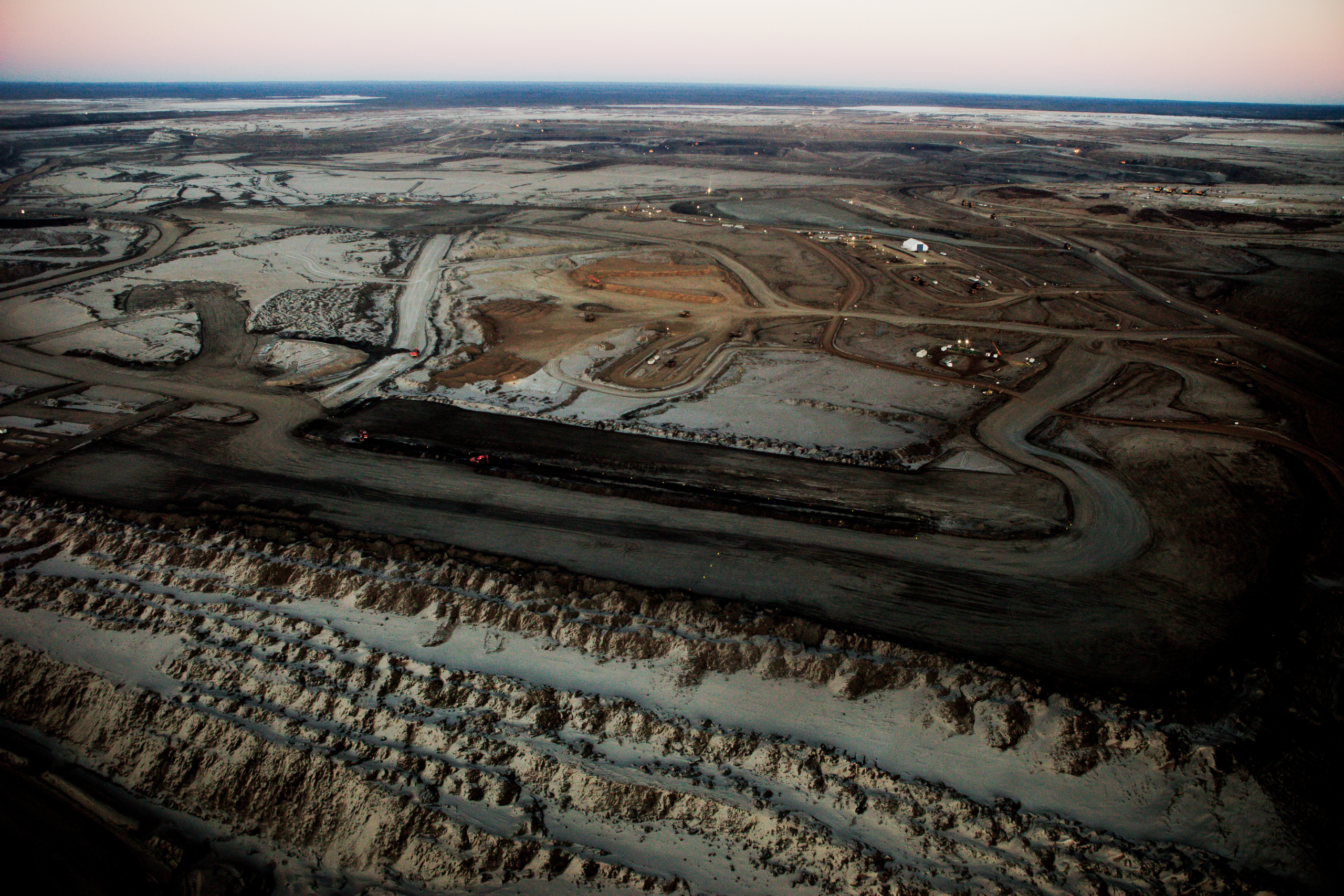A version of this story appears at The Tyee, an independent Canadian news site.
WHEN OIL GIANT Total SA announced a write-down of $7 billion in Canadian oil sands assets this summer, the French company said long-term development of those projects wouldn’t be in line with its climate commitments.
That rationale was reflected in press coverage of the company’s move. However, when Canada’s national newspaper the Globe and Mail interviewed the head of the country’s largest heavy crude oil producer following Total’s announcement, the resulting article quoted Canadian Natural Resources Ltd. president Tim McKay as blaming oil sands divestments on the “stigma” attached to such projects.
Left unmentioned in the Globe piece was the fact Total seemed less concerned with the climate stigma and more concerned that demand for its Canadian reserves would likely shrivel up. That worry is well founded, with the International Energy Agency forecasting that efforts to address a warming planet would sharply cut the world’s demand for crude from almost ninety-seven million barrels per day in 2018 to just over fifty million barrels per day in thirty years’ time.
But the Canadian press barely seems to mention this industry contraction when reporting on some of its most powerful players. When I examined how many of the country’s English-language newspapers covered Canada’s so-called Big Five oil companies during a two-month period earlier this year, I found 295 pieces referencing Canadian Natural Resources, Suncor Energy Inc., Cenovus Energy Inc., Imperial Oil Ltd., or Husky Energy Inc. After eliminating stories that named the Big Five but weren’t directly about the fossil fuel business—such as unrelated stock market updates or a report about traffic lights being installed near one of their properties—I counted 173 pieces, just 15 of which explicitly mentioned there could be less future oil demand. One even quoted Suncor’s president and chief executive officer, Mark Little, saying, “We don’t think that’s a solution,” in reaction to demands to cut carbon emissions by curtailing production.
That statement was newsworthy enough to top a story in the National Post, a competitor to the Globe. Three days later, Little said during a fourth-quarter earnings call, “I think people are concerned about lots of companies talking about growing oil production forever. We know that can’t happen.” However, his quote appears to have gone unreported by the news media.
That’s one of many shortfalls I found in how Canadian newspapers have covered some of the world’s most climate-wrecking companies. At a time when financiers are figuring out that doing business with oil companies might be bad business, that realization doesn’t yet appear to have reached the journalists covering the Big Five. The result is a journalistic failure that contributes to the climate crisis, rather than soberly assessing it.
CNN PUBLIC EDITOR: The only question in news is ‘Will it rate?’
The Big Five are so named because, according to the Canadian government, they are responsible for over half of the crude oil production in the country, which is the world’s fourth-largest exporter of that commodity. Three of the Big Five—Canadian Natural Resources, Husky, and Suncor—are also among the hundred companies linked to 71 percent of industrial greenhouse gas emissions released between 1988 and 2015.
I examined how Canada’s mainstream media covered the Big Five from January 9 to March 11—a period that ended with the novel coronavirus being declared a pandemic. During that two-month period, Cenovus announced its “ambition” to reach net-zero emissions by 2050, the world’s largest investment manager warned the climate crisis would cause a “significant reallocation of capital,” CNBC’s Jim Cramer compared fossil fuel stocks to tobacco companies, and the Financial Times estimated aggressive action to restrict global heating would result in $900 billion in stranded fossil fuel assets. During the same period, Jason Kenney, the conservative premier of Alberta, where most of Canada’s oil sands are located, also acknowledged there would be a “gradual shift” away from fossil fuels—something one prominent local columnist described as a “crucial change of tone” for Kenney’s government, which is cultishly committed to the oil and gas industry.
Combined with a controversial and now shelved proposal to build a huge new oil sands mine in Alberta, Canadian newspapers had at least six major opportunities to cover the intersection between the climate crisis and the Big Five during this period. But what I found instead were missed opportunities.
The 173 pieces I analyzed included briefs, news reports, columns, editorials, op-eds, and advertorials; they reported directly on Big Five companies, recommended investing in them, or else referenced them as part of covering the oil and gas sector. Most were written by journalists at the Globe and Mail (31 percent), the Canadian Press wire service (20 percent), the National Post (11 percent), and the Calgary Herald (8 percent). Forty-four percent of those articles’ journalistic bylines came from Calgary, the Albertan city where the Big Five are headquartered, while 35 percent came from Toronto. So, despite the importance of the Big Five and other parts of the fossil industry, newspapers in other parts of the country didn’t pay them much attention.
In part, that’s likely because decades of cutbacks, layoffs, and mismanagement have emptied local newsrooms in Canada, just as they have in the US and the rest of the world, gutting the breadth and depth of their reporting. But it’s also because business beat reporters and columnists were among the few newspaper journalists who seemed interested in covering, commenting on, or even just mentioning the Big Five. They accounted for 77 percent of the journalistic bylines above the 173 articles examined, even though the impact of the Big Five reaches far beyond their oil fields and into many other beats.
That said, climate change was a routine part of coverage: 34 percent of the articles mentioned terms associated with that phenomenon. But just nine articles featured an interview with an environmentalist. And only seven included information about the environmental impact of the climate crisis, which was usually limited to how much the world’s temperature could increase.
At the same time, Postmedia, the country’s largest newspaper chain, continues to publish commentary boosting fossil fuels and blasting climate action. “Lots more oil still to come,” read the headline over one such column in the articles I analyzed. Another favorably quoted Kenney urging Canadians to take “concrete” emission reduction measures “instead of shutting down modernity.” And an op-ed by a senior fellow from the free-market Fraser Institute stated that “many people, including experts, sincerely disagree that human-caused climate change is analogous to a ship heading for an iceberg.”
At least some Postmedia journalists must know how wrongheaded those statements are. After all, when Total announced its oil sands write-down, the National Post published a video that wondered, “Is the end-game near for oil?” In answering that question, the video stated “stringent climate change policies” will “dampen” long-term oil demand. Similarly, the Globe published an article on the same day that mentioned forecasts that the world may have already hit peak oil demand.
Nevertheless, this wider environmental and economic context too often seems lost when Canadian newspapers narrow their coverage to individual oil companies, specifically the Big Five. I found little evidence of journalists pressing the Big Five’s presidents and chief executive officers about their own dim future and their responsibility for forcing such a future on everyone else.
Canadian newspapers, and the news media as a whole, must do better. Journalists across Canada, regardless of their beats and irrespective of the size of their outlets, should be asking more and harder questions about what those companies are doing to avert climate disaster.
The consequence of not doing so is that the Big Five’s chairs, board members, and executives continue being even more insulated from the growing global pressure against the oil and gas industry than they already are in Alberta, the heart of climate denialism in Canada. Journalists are often said to be responsible for the first draft of history. Canadian newspapers need to get on the right side of it.
COVERING CLIMATE NOW: The sitting president has no climate plan. Why isn’t that headline news?




